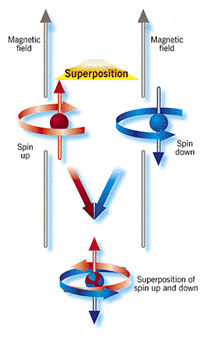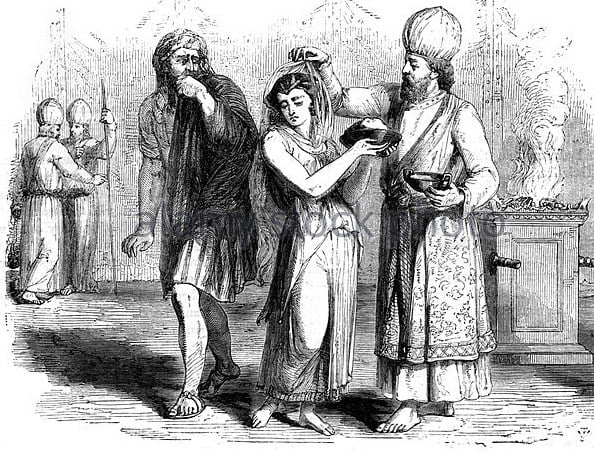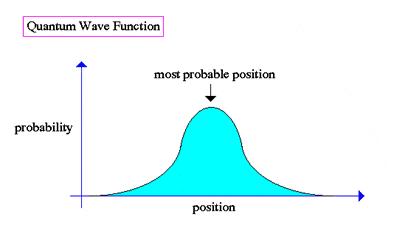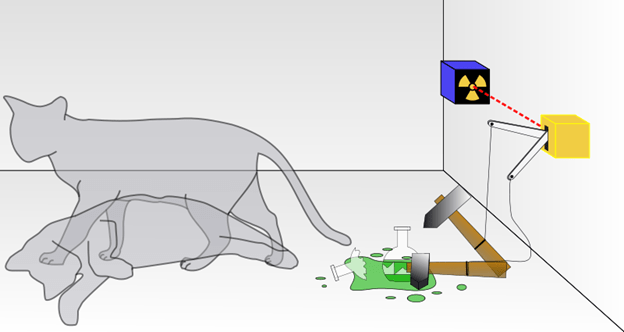In quantum mechanics, the state of a physical system is described by the so-called wave function (or the “wavefunction”). All attempts by Schrödinger, who first introduced the wave function, and others to interpret it as a scalar potential of some physical field, or as the de Broglie wave (as in particle-wave dualism) were not successful. In 1926, Max Born noticed that the squared amplitude of the wavefunction of a particle in a given region gives the probability of finding the particle in this region. He suggested that the wavefunction represented not a physical reality but rather our knowledge of the quantum state of an object.
The wave function represents our knowledge of all possible quantum-mechanical states of an object and their probabilities. In other words, the quantum-mechanical state of a physical system is a linear superposition (in its simplest form, linear superposition is a sum) of all possible states of this system. Thus, for example, in state A, an electron can have its spin up (as if 
In another example, the state vector for a left circularly polarized photon is a linear superposition of the vertical and horizontal states.

What actually happens during the collapse of the wavefunction is that the previously amorphous reality existing in an undetermined state of various possibilities suddenly comes into a tangible physical reality in one particular state. The same thing happens when we measure the spin of an electron, which in a state of superposition of up and down. Upon measurement, it collapses into one of two possible states: either spin-up or spin-down. According to at least some interpretations of quantum mechanics, the collapse of the wavefunction requires a conscious observer (ba’al da’at).
Schrödinger did not like cats—he was allergic to them. Perhaps this is why, he chose the unfortunate feline for his now famous Schrödinger Cat gedankenexperiment (i.e., thought experiment) . In this thought experiment, one places a cat in a closed steel chamber, together with a Geiger tube containing some radioactive material, a hammer connected to the Geiger tube, and a vial of prussic acid or other poison. From the amount of the radioactive material and its half-life, we calculate that there is a 50% chance that within, say, one hour, one atom will decay. If an atom decays, the Geiger counter is triggered and causes the hammer to break the vial of prussic acid, which kills the cat.
Prior to the measurement, the wave function of the atom is a linear superposition of two possibilities: decayed and not-decayed atom. Accordingly, the wave function of the cat (which is entangled with the rest of the experimental setup) is also a linear superposition of two physical possibilities: the cat is alive and the cat is dead. In other words, before the measurement takes place, the cat is dead and alive at the same time! Or, to be more precise, the cat is neither alive nor dead, nor both, nor neither, but is in a state, which is a blurred combination of both possible states.
Another interesting quantum-mechanical concept is entanglement. If two particles are born out of the decay of a single particle, they will remain entangled. If two particles collide and bounce off each other going their merry ways, they will remain entangled. In fact, if two particles interact in any way so that the quantum state of each particle cannot be described separately but only as a unit, they remain entangled. To be entangled means that they share the same wave function (or the same state).
This leads to a very interesting phenomenon—if the two entangled particles are each in a state of superposition and we measure one, thereby collapsing its wavefunction, the other particle’s wavefunction collapses simultaneously.
Say two electrons collide and bounce off traveling to far corners of the universe. Their spins are in a state of superposition of spin-up and spin-down states. If we measure the spin of the first particle fixing it, say, in the state spin-up, the other electron immediately collapses into a state with spin-down (according to the momentum conservation law, the spins must be in the opposite direction).
Let me give a very crude example. Let’s take a coin and slice it in two very thin halves—one is head and the other is tails (does the Biblical half-coin, machtzit hashekel, come to mind?). Let us put the two half-coins in a bag, shake it up and, without looking, put one half-coin into one envelope and the other half-coin and the second envelope. We don’t know which half-coin got into which envelope. We will then mail one envelope to Shimon and the other envelope to Reuven. When Reuven opens his envelope and finds there the tails half-coin, he knows immediately that Shimon got the heads half-coin in his envelope, without having to call Shimon and asking him to open his envelope.
Another crude example is if are shopping for gloves and pick up from the shelf a box with a pair of gloves. You draw the first glove from the box and it turns out to be a left-handed glove. You don’t need to look inside the box to know that the other glove is the right-handed glove. Quantum-mechanical entanglement is much deeper and more complicated, but these oversimplified examples will suffice for our purposes.
The Torah portion Naso describes the ceremony for the Sotah, a suspected adulteress, who was witnessed being secluded with another man, despite having been forewarned by her husband not to socialize with that man. The wayward wife ignites jealousy of her husband who brings her to the Holy Temple in Jerusalem, Bet HaMikdash. A kohen (priest) offers the woman a plea-bargain: plead guilty, admit the sin, and go free. If she accepts the plea-bargain and pleads guilty, the bill of divorce (get) is written and she is set free—divorced from her husband, but spared capital punishment. If she does not admit her adultery and maintains her innocence, she is tried by ordeal. However, before commencing the trial, the kohen drags her around the Temple courtyard until she is worn out; he undoes her hair to publically humiliate her, all the while imploring her to admit her sin. If she still refuses the plea-bargain, the trial commences.
This very section of the Torah is written on a parchment and then soaked in water until the ink dissolves. The woman is admonished about the terrible curses she would bring upon herself, if she is guilty, by drinking the liquid that will become a poison to her. The woman is then forced to drink the bitter waters. If she indeed committed adultery, her belly would miraculously swell and she would die a painful death, as would her paramour. But, if she is innocent, she would be unharmed by the waters, cleared of any suspicion, and blessed with many children and easy childbirth.
This trial by ordeal is a very strange ritual. Many questions come to mind… If the woman, in fact, did not commit an act of adultery, why does she deserve to be subjected to such humiliation? Why are we trying to compel her to plea-bargain—admit her guilt (whether she actually did it or not) and be set free, avoiding capital punishment? Why do we dissolve this Torah portion in the water? Isn’t it forbidden to erase the holy name of G‑d? And, if she was guilty and dies from drinking the bitter waters, how does her lover die? He did not drink any of the water!
To understand what is going on here, we will generalize the quantum-mechanical concepts of superposition and entanglement to any system or object. If a system can be in a state A and a state B (whatever that states may be), we will say that, when there is no information about the state, the system is in a state of superposition of A and B. We will also say that any two objects, once interacted, remain entangled constituting one system.
Based on these definitions, the husband and wife are entangled (not in the quantum-mechanical sense, of course, but in this metaphorical sense). Spouses are connected by the bonds of marriage. Just like entangled electrons must have their spins pointing in the opposite directions (if one up, the other must be down), so in a family relationship, if one spouse is a husband, the other must be a wife; if one is a male the other one must be a female (the Bible does not allow same-sex marriage). Just as two entangled particles form a single unit—they share the same wave function—two spouses form a single unit, a family. Just as one particle can only be entangled with one more particle (“quantum monogamy” principle), a wife can only be entangled to one husband. If a Sotah is guilty of adultery, not only does she die an unnatural death, but the man with whom she has sinned dies too because the two of them became entangled.
Sotah impermissibly entangles with another man by secluding herself with him in a room without witnesses. Just as the Schrödinger Cat is in a blurred state of superposition of being dead and live, the Sotah is in a state of superposition of being innocent and guilty, of being pure and impure. To emphasize, the Sotah is not innocent or guilty, pure or impure. Rather she is in a blurred state of superposition of being innocent and being guilty, of being pure and being impure at the same time. What’s worse, she is now entangled with two men, which is an untenable situation!

The only other solution is for Omniscient G‑d to intervene by revealing His knowledge (the Supernal Knowledge, Daat Elyon), thereby collapsing the wave function.
There is, of course, a deeper spiritual reason why a woman can be entangled with only one man. In a relationship with G‑d, we are the receivers, which is the feminine aspect of the relationship, while the Creator is on the giving end of this relationship, which is the masculine aspect. Generally, in Kabbalah, whenever we talk about male and female, we mean a giver (or the aspect of giving) and a receiver (or the aspect of receiving).
Metaphorically, this is expressed by calling the Jewish people a bride and G‑d our husband. We are married to G‑d, as it were. The Torah tablets were our wedding ring and the day of Matan Torah, the giving of the Torah on Mt. Sinai, is our wedding anniversary. When Jews worshiped Golden Calf in the desert, it was described as an act of adultery. Moses burnt the Golden Calf and ground it into dust mixing it with water, which he forced Jews to drink. This has a direct parallel with the ceremony of Sotah, who is forced to drink bitter waters mixed with the dust from the Temple floor, in which the ink of the curse was dissolved.
Just as we cannot have another G‑d, a married woman cannot have another husband or paramour. To make sure that G‑d does not choose another nation to be his “bride” (according to the Biblical law, a man can have more than one wife), Rabbeinu Gershon instituted a law that a man can have only one wife. Now, this relationship is completely symmetrical. Just as in quantum mechanics only two particles can be entangled with each other, only two people, a man and a woman, can be married.




This implies a woman is not a proper observer but men are…. don’t know about that…
Good question! Please note, however, that the male companion of the Sotah, cannot collapse the wave function either. As you can see, it has nothing to do with the gender of the observer. It has to do with the relativity of the collapse of the wavefunction. The knowledge of the Sotah and her paramour does not affect our knowledge — in our frame of reference, there were no witnesses who could collapse the wavefunction.